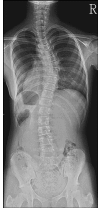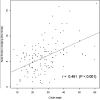Differential wedging of vertebral body and intervertebral disc in thoracic and lumbar spine in adolescent idiopathic scoliosis - A cross sectional study in 150 patients
- PMID: 18700985
- PMCID: PMC2527554
- DOI: 10.1186/1748-7161-3-11
Differential wedging of vertebral body and intervertebral disc in thoracic and lumbar spine in adolescent idiopathic scoliosis - A cross sectional study in 150 patients
Abstract
Background: Hueter-Volkmann's law regarding growth modulation suggests that increased pressure on the end plate of bone retards the growth (Hueter) and conversely, reduced pressure accelerates the growth (Volkmann). Literature described the same principle in Rat-tail model. Human spine and its deformity i.e. scoliosis has also same kind of pattern during the growth period which causes wedging in disc or vertebral body.
Methods: This cross sectional study in 150 patients of adolescent idiopathic scoliosis was done to evaluate vertebral body and disc wedging in scoliosis and to compare the extent of differential wedging of body and disc, in thoracic and lumbar area. We measured wedging of vertebral bodies and discs, along with two adjacent vertebrae and disc, above and below the apex and evaluated them according to severity of curve (curve < 30 degrees and curve > 30 degrees ) to find the relationship of vertebral body or disc wedging with scoliosis in thoracic and lumbar spine. We also compared the wedging and rotations of vertebrae.
Results: In both thoracic and lumbar curves, we found that greater the degree of scoliosis, greater the wedging in both disc and body and the degree of wedging was more at apex supporting the theory of growth retardation in stress concentration area. However, the degree of wedging in vertebral body is more than the disc in thoracic spine while the wedging was more in disc than body in lumbar spine. On comparing the wedging with the rotation, we did not find any significant relationship suggesting that it has no relation with rotation.
Conclusion: From our study, we can conclude that wedging in disc and body are increasing with progression on scoliosis and maximum at apex; however there is differential wedging of body and disc, in thoracic and lumbar area, that is vertebral body wedging is more profound in thoracic area while disc wedging is more profound in lumbar area which possibly form 'vicious cycle' by asymmetric loading to spine for the progression of curve.
Figures






Similar articles
-
Comparison of disc and vertebral wedging between patients with adolescent idiopathic scoliosis and Chiari malformation-associated scoliosis.J Spinal Disord Tech. 2012 Jul;25(5):277-84. doi: 10.1097/BSD.0b013e31821f4f10. J Spinal Disord Tech. 2012. PMID: 21617568
-
Segmental Characteristics of Main Thoracic Curves in Patients with Severe Adolescent Idiopathic Scoliosis.World Neurosurg. 2018 Nov;119:e174-e179. doi: 10.1016/j.wneu.2018.07.086. Epub 2018 Jul 18. World Neurosurg. 2018. PMID: 30031188
-
Contribution of coronal vertebral and IVD wedging to Cobb angle changes in adolescent idiopathic scoliosis during growth.BMC Musculoskelet Disord. 2022 Oct 10;23(1):904. doi: 10.1186/s12891-022-05863-z. BMC Musculoskelet Disord. 2022. PMID: 36217198 Free PMC article.
-
[Correlation study between spinal curvatures and vertebral and disk deformities in idiopathic scoliosis].Ann Chir. 1999;53(8):798-807. Ann Chir. 1999. PMID: 10584392 French.
-
On growth and scoliosis.Eur Spine J. 2024 Jun;33(6):2439-2450. doi: 10.1007/s00586-024-08276-9. Epub 2024 May 5. Eur Spine J. 2024. PMID: 38705903 Review.
Cited by
-
Pre-operative parameters influencing vertebral body tethering outcomes: patient's characteristics play an important role in determining the outcomes at a minimum of 2 years post-op.Spine Deform. 2023 Nov;11(6):1389-1397. doi: 10.1007/s43390-023-00739-1. Epub 2023 Aug 2. Spine Deform. 2023. PMID: 37528248
-
Metabolic Effects of Angulation, Compression, and Reduced Mobility on Annulus Fibrosis in a Model of Altered Mechanical Environment in Scoliosis.Spine Deform. 2013 May;1(3):161-170. doi: 10.1016/j.jspd.2013.02.001. Epub 2013 Jun 6. Spine Deform. 2013. PMID: 27927288 Free PMC article.
-
Post-trauma scoliosis after conservative treatment of thoracolumbar spinal fracture in children and adolescents: results in 48 patients.Eur Spine J. 2016 Apr;25(4):1144-52. doi: 10.1007/s00586-014-3744-6. Epub 2015 Jan 9. Eur Spine J. 2016. PMID: 25572148
-
Defining risk factors for adding-on in Lenke 1 and 2 AR curves.Spine Deform. 2021 Nov;9(6):1569-1579. doi: 10.1007/s43390-021-00382-8. Epub 2021 Jul 3. Spine Deform. 2021. PMID: 34216354
-
Sexual Dimorphism and the Origins of Human Spinal Health.Endocr Rev. 2018 Apr 1;39(2):221-239. doi: 10.1210/er.2017-00147. Endocr Rev. 2018. PMID: 29385433 Free PMC article. Review.
References
-
- Taylor TK, Ghosh P, Bushell GR. The contribution of the intervertebral disk to the scoliotic deformity. Clin Orthop. 1981;156:79–90. - PubMed
-
- Braun JT, Ogilvie JW, Akyuz E, Brodke DS, Bachus KN, Stefko RM. Experimental scoliosis in an immature goat model: a method that creates idiopathic-type deformity with minimal violation of the spinal elements along the curve. Spine. 2003;28:2198–203. doi: 10.1097/01.BRS.0000085095.37311.46. - DOI - PubMed
-
- Perdriolle R, Becchetti S, Vidal J, Lopez P. Mechanical process and growth cartilages. Essential factors in the progression of scoliosis. Spine. 1993;18:343–9. - PubMed
-
- Mehlman CT, Araghi A, Roy DR. Hyphenated history: the Hueter-Volkmann law. Am J Orthop. 1997;26:798–800. - PubMed
LinkOut - more resources
Full Text Sources
Miscellaneous

